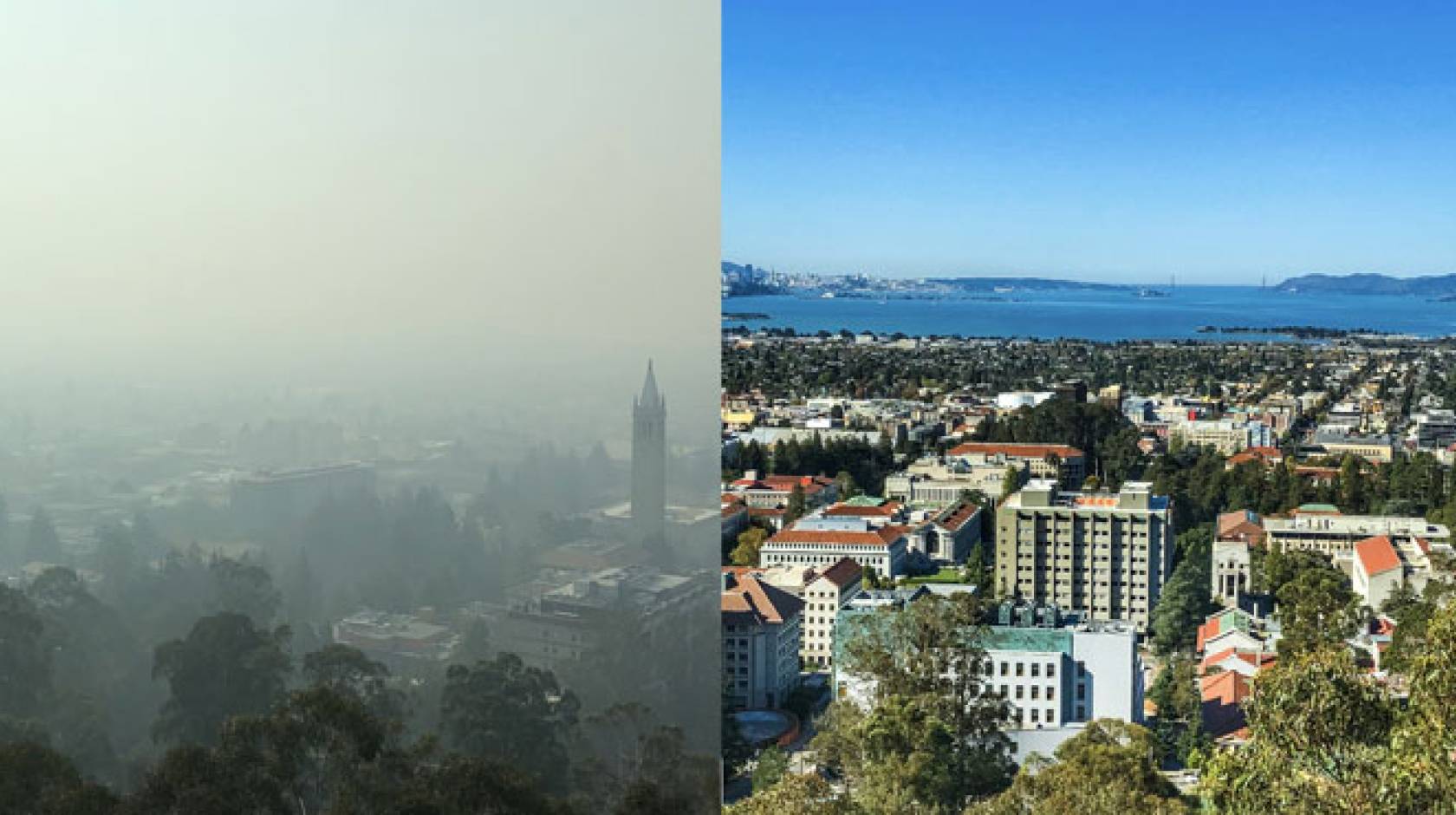Brett Singer, Berkeley Lab

Editor's note: This article was originally published on Nov. 14, 2018. It has been reviewed by the researchers as of Aug. 20, 2020, to ensure it is up-to-date and updated with new information about PurpleAir.
Brett Singer and Woody Delp are internationally recognized experts in the field of indoor air quality. Singer is a Principal Investigator and Staff Scientist; Delp is a Research Engineer in the Indoor Environment Group and the Whole Building Systems Department of the Energy Technologies Area, Berkeley Lab.
Singer and Delp have conceived, conducted, and led research projects related to air pollutant emissions, physical-chemical processes, and pollutant exposures in both outdoor and indoor environments. Their research aims to understand the real world processes and systems that affect air pollutant exposures. One of the goals of their work is to inform the design, construction, and operation of high-performance buildings for public benefit.
Q: How worried should I be about the air pollution from a wildfire?
The risks of air pollution exposure vary widely across people and as pollutant levels change. The U.S. EPA offers a simple, color-coded guide called the Air Quality Index or AQI. If you have a chronic heart- or breathing-related condition, caution is warranted any time the AQI in your area moves to yellow (Moderate), and you should take action to protect yourself whenever it gets to orange (Unhealthy for sensitive groups). When air pollution is in the red (Unhealthy) or worse, even healthy people are at increased risk of irritation and respiratory infection. More information about the AQI here.
Q: Where can I find information about the air quality near me?
The U.S. EPA works with state and local air management districts to measure and predict air quality around the country. Data and predictions from their AirNow system are available here.
This site (Air Visual) combines data from AirNow with meteorological models to show both air quality and prevailing winds (with data from their network of low-cost monitors available on limited basis). This site (Purple Air) shows data from a network of low-cost air quality monitors.
One thing to be aware of, according to Delp, is that low-cost consumer devices used in these maps will overreport the actual numbers. With PurpleAir, for example, make sure to select the LRAPA conversion to get numbers in the right ballpark. Conversion options are available and explained in the map legend.
For in-home monitoring, a recent Berkeley Lab study identified four low-cost monitors that you can use at home.
Q: How can I protect myself during wildfire air pollution events?
Stay indoors with the windows closed and use air filtration if available. In a closed building, the levels of fire-related air pollutants will generally be lower inside than outside; but the reduction varies widely across buildings. In leaky houses without filtration the reduction may be as little as 10 percent. See below for guidance on filtering the air.
Refrain from vigorous activities. Being active raises breathing rate and volume — which increases your intake of air pollutants — and allows pollutants to penetrate deeper into your lungs. And be mindful that even if you work out in a space with clean air — like a gym that has a good filtration system — an effect of being exposed to air pollutants throughout the day is that you may become tired more easily.
Wear N95 respirator masks. These can reduce your pollutant intake when you have to be outdoors or inside buildings that offer limited protection. See below for more information.
Spend as much time as possible in spaces that have clean, filtered air. Even if you can’t be in clean spaces all the time, it is helpful to give your body a break. See below for actions you can take to improve the air quality in your home.
Attend to general wellness practices. These general good health practices can reduce your susceptibility to respiratory infections and other air pollution related health effects.
- Get enough sleep
- Stay hydrated
- Eat a healthy and balanced diet
Q: Do respirators and/or masks help?

Credit: Woody Delp/Berkeley Lab
Yes, but they must be the right kind and they must be worn properly. Respirator masks rated as N95 and P100 can substantially reduce intake of fine particles when worn properly. Surgical masks are not effective. When using an N95 mask, please pay attention to the following considerations:
- If you have a medical condition that makes it hard for you to breathe, consult your doctor before using a respirator. And note that respirators are not sized or recommended for children.
- Make sure there is a good fit and seal. You should only use N95 masks with two straps; a single strap cannot seal adequately. If one doesn’t fit right, try another brand. Simple tests on the fit are whether can you see gaps around the edges and whether you still smell smoke while wearing it. Facial hair interferes with a proper seal and may reduce effectiveness.
- Some respirators have a valve that makes it easier to breathe. These typically cost $3 or less when buying individually and $2.50 or less when buying in bulk. One example of this type is the 3MTM Particulate Respirator 8210V.
- Even when wearing a respirator, you should limit time outdoors and avoid vigorous activities. Heavier breathing interferes with the seal and can make them ineffective.
- Don’t wear a respirator that makes it very difficult for you to breathe. They are usually uncomfortable but you should be able to breathe without distress.
More guidance: California Dept of Public Health Guidance on Respirators
Q: How can I make my home safer?
The benefits you get from being inside your home depend on two factors:
- How much can you reduce the rate that outdoor air and pollutants enter your home?
- How much can you increase pollutant removal through use of a filtration system?
Keep windows closed and turn off continuous ventilation systems. Many of the air pollutants in wildfire smoke are slowly removed as air inside your home comes into contact with materials and surfaces. If you slow the rate of air pollutants entering, you allow more time for the removal processes to happen and pollutant levels drop.
Many recently constructed homes and some that have undergone extensive retrofits have a mechanical ventilation system to ensure they get enough outside air under normal conditions. (In California the most common system is an exhaust fan in the laundry room that is designed for continuous operation. Elsewhere the systems may bring in outdoor air through the forced air system, with a control on the thermostat or “Air Cycler” unit.) In most cases, mechanical ventilation should be turned off during severe outdoor air pollution events. The exception is a system with a high efficiency filter. If you live in an ultra-tight home, such as a Passive House, you should not turn off your ventilation system. Instead, you should rely on filtration. See below for guidance on filter selection.
Q: How do I use filtration systems in my home?
Broadly, there are two ways to filter air and remove pollutants in your residence:
- Use the forced air heating (or heating and cooling) system. If hot or cold air blows out from registers around your house, you have this type of system.
- Use portable or standalone air filtration devices.
Filtration effectiveness depends on two factors:
- How much air moves through the filter.
- How efficiently the filter removes particles and other pollutants from the air that moves through it.
The product or combination of these two factors provides the effective clean air delivery rate.
The U.S. Environmental Protection Agency recently put out this guidance document that provides valuable information about air cleaning technologies for homes.
Q: What should I know about using the central forced air system in my home to clean the air?
Your forced air heating and cooling system has the advantage of moving enough air to improve air quality throughout the house, but only if the filter has high pollutant removal efficiency.
An important caution is that operating the forced air system can increase outdoor air and pollutant entry. The reason is that ductwork in the vented attic, crawl space, or garage can have leaks. If you have a high efficiency filter, you will still usually benefit from operating the system. If you don’t have a high efficiency filter, bringing in more outdoor air can make things worse. See below for guidance on how to select a high efficiency filter.
Operate your system in “fan on” mode.
- Modern forced air systems can be operated in “Fan” mode, in which the system moves air through the ducts and filter without heating or cooling it. If you can’t figure out how to do this, look online for help or contact the thermostat maker.
- Older thermostats may have a switch for “Fan setting” with two options: “Auto” and “On.” Choose “On.”
- In some older houses, the thermostat may have a “Fan – On” option that doesn’t actually turn the fan on. Check if this setting works by feeling if air is coming out of the supply grilles.
Filter selection and installation guidance. To check or change a filter, you first have to find it. There are generally two places where filters are installed.
- At the return grille(s). The return grille is where air from your house is sucked back into the forced air system for conditioning. These are larger than the registers where conditioned air is provided to your living space. Many houses have two or more return grilles.
- At the forced air unit. The forced air heating and cooling unit may be in the attic, garage, basement, or crawl space.
For general information about filter selection, including the importance of selecting the correct size, please visit this Berkeley Lab site.
For home filters, there are several different filter rating systems. “MERV” is an industry standard used by many filter manufacturers. Honeywell uses its own “FPR” system, and 3M uses their MPR system. The table below provides recommendations for good and best filters.
The following filters are recommended:

Credit: Woody Delp/Berkeley Lab
- Do not use a HEPA filter or MERV 16 unless your system is designed for it. These filters have higher resistance and can greatly reduce airflow.
- When installing a filter, check that there are no visible gaps for air to flow around the filter and make sure the filter cabinet is tightly closed.
Q: What should I know about using portable air purifiers to clean the air?
- Size it for the space. They work better in rooms that are closed from other parts of the house, such as bedrooms. If you don’t have enough devices for your entire residence, create one or more clean air zones within your home. The Association for Home Appliance Manufacturers (AHAM) provides a list of air cleaners with verified clean air delivery rates (CADR. AHAM recommends selecting a unit with a CADR that is at least two-thirds of the floor area of the room; so for a room that is 120 square feet, you should have a CADR of at least 80. If the room is open, a higher CADR is needed.
- For large spaces and open floor plan apartments or houses, use multiple units.
- If you live in tight house and you turn off mechanical ventilation, air cleaners will be effective in larger spaces than the manufacturer guidance. If you live in a very leaky house (typical for older homes), pay careful attention to guidelines.
- Caution: Make sure the air cleaner does not emit ozone. Check for “CARB certified.”
- Caution: don’t rely on the “auto” setting. These have low-cost particle sensors that are often not accurate. Operate on highest speed that you can tolerate.
- Note that the sizing recommendation is for the unit to operate at the highest speed setting, which will also be the loudest. If you want quieter operation, you can select a unit that is sized for a larger space and operate it at a lower setting.
Berkeley Lab has more information here.
Q: Can I make my own air filtration unit?
Yes, using a 20-inch box fan and 20-inch square filters. Instructions are here. These will work better with deeper, 4-inch filters, which can be purchased online. One-inch filters that are available at hardware stores will also work if you select one that is in the “Best” category under filter selection.
Q: What about when I’m in my car?
When traveling in a car that has a good cabin air filter, operate the ventilation system in recirculation mode using the medium to high fan setting. Some cars have excellent cabin air filtration and many modern vehicles have filters that are at least good enough to help. If you find the air quality to be worse when operating the ventilation system, turn it off.

